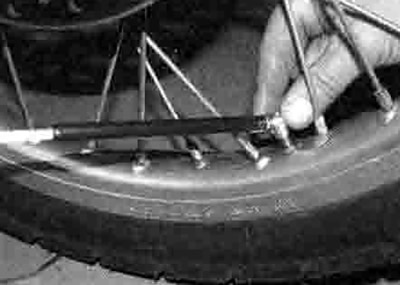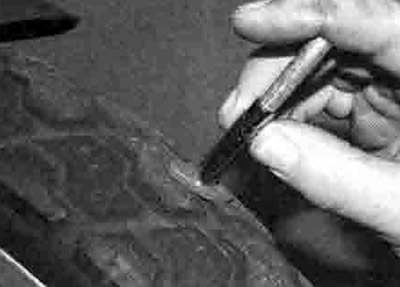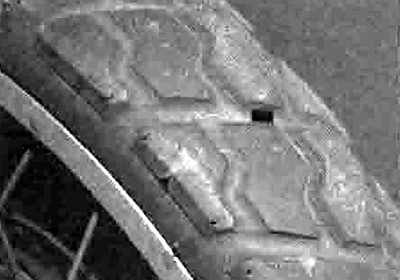The correct pressures
- The tyres must be checked when cold, not immediately after riding. Note that low tyre pressures may cause the tyre to slip on the rim or come off. High tyre pressures will cause abnormal tread wear and unsafe handling.
- Use an accurate pressure gauge. Many forecourt gauges are wildly inaccurate. If you buy your own, spend as much as you can justify on a quality gauge.
- Proper air pressure will increase tyre life and provide maximum stability and ride comfort.
Tyre care
- Check the tyres carefully for cuts, tears, embedded nails or other sharp objects and excessive wear. Operation of the motorcycle with excessively worn tyres is extremely hazardous, as traction and handling are directly affected.
- Check the condition of the tyre valve and ensure the dust cap is in place.
- Pick out any stones or nails which may have become embedded in the tyre tread. If left, they will eventually penetrate through the casing and cause a puncture.
- If tyre damage is apparent, or unexplained loss of pressure is experienced, seek the advice of a tyre fitting specialist without delay.
Tyre tread depth
- At the time of writing UK law requires that tread depth must be at least 1 mm over 3/4 of the tread breadth all the way around the tyre, with no bald patches. Many riders, however, consider 2 mm tread depth minimum to be a safer limit. Honda recommend a minimum of 1.5 mm on the front and 2 mm on the rear.
- Many tyres now incorporate wear indicators in the tread. Identify the location marking on the tyre sidewall to locate the indicator bar and replace the tyre if the tread has worn down to the bar.
All XL600V and XL650V models, XRV750-L to N (1990 to 1992) models
| Loading | Front | Rear |
| Rider only | 29 psi (2.00 Bar) | 29 psi (2.00 Bar) |
| Rider and passenger | 29 psi (2.00 Bar) | 33 psi (2.25 Bar) |
| Loading | Front | Rear |
| Rider only | 29 psi (2.00 Bar) | 29 psi (2.00 Bar) |
| Rider and passenger | 29 psi (2.00 Bar) | 36 psi (2.50 Bar) |
1. Remove the dust cap from the valve and check the tyre pressures when cold. Do not forget to fit the cap after checking the pressure.

2. Measure tread depth at the centre of the tyre using a depth gauge.

3. Туге tread wear indicator bar and its location marking (usually either an arrow, a triangle or the letters TWI) on the sidewall.

